Fish and lampreys
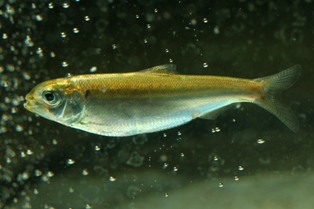 " typeof=
The Allis Shad (Alosa alosa), a clupeid migratory fish reaching a size of up to 70 cm, was considered extinct in the river Rhine for more than 50 years. In 19th century hundreds of thousands of individuals had migrated several hundreds of kilometres upstream to the North Sea and the Atlantic ocean for reproduction. The allis shad was one of the most important species of commercial fishery in the Rhine. In the state of Nordrheinwestfalen a separate Life project is dedicated to the re-introduction of allis shad in the Rhine river – it shows already first successful results: the shad larvae have already developed into juvenile fish. It is expected that only single fish will migrate upstream. But perhaps the species will use the shingle banks near Au am Rhein as spawning ground in future years. Read more
" typeof=
The Allis Shad (Alosa alosa), a clupeid migratory fish reaching a size of up to 70 cm, was considered extinct in the river Rhine for more than 50 years. In 19th century hundreds of thousands of individuals had migrated several hundreds of kilometres upstream to the North Sea and the Atlantic ocean for reproduction. The allis shad was one of the most important species of commercial fishery in the Rhine. In the state of Nordrheinwestfalen a separate Life project is dedicated to the re-introduction of allis shad in the Rhine river – it shows already first successful results: the shad larvae have already developed into juvenile fish. It is expected that only single fish will migrate upstream. But perhaps the species will use the shingle banks near Au am Rhein as spawning ground in future years. Read more- " typeof= The Salmon (Salmo salar) is the most well-known anadromous fish species, i.e. it migrates from the sea into rivers and streams for spawning. The river Rhine constitutes the major migration corridor for the species, and it spawns in the stream beds over coarse gravel in the larger streams and rivers of the Black Forest (e.g. Alb, Murg, Kinzig). There are still only few evidences of the salmon in the river Rhine. Read more
- " typeof=
- The European Bitterling (Rhodeus sericeus amarus) can be identified from its cyan stripe towards the tail. It lives in smalls shoals in standing or slowly flowing waters with water vegetation. Its reproduction is unique: via a special pipe the female lays its eggs into the gill of large mussels. After hatching the juveniles stay inside the mussels for a while. Due to this dependency the species needs intact populations of swan mussels or freshwater mussels. If these disappear the bitterling can also not exist any more. In the area bitterlings and mussels have mainly been found in the Illinger Altrhein and in the adjacent quarry pond Kindelsgrund. Read more
 " typeof=
" typeof=
- The European Weatherfish (Misgurnus fossilis) is one of the few fish species that can survive the temporary dry out of its water habitat. In this case it buries itself in the mud, breathing through skin and intestines instead of its gills. Additionally, it can fall into a extended sleep until conditions improve. It is a nocturnal fish species, mainly feeding on mussels, insects and snails it roots out on the bottom of the stream or pond. In the area it has been mapped in the Winterdorfer Altrhein. Read more
 " typeof=
" typeof=
- If the Spined Loach (Cobitis taenia) discharges the sand, which it has incorporated together with small animals and algae, it looks as if it had eaten stones, therefore its German name “stone-eater”. It is a rather nocturnal species, during the day hiding in the sand, with only the head poking out. The spined loach settles in all back waters of the Altrhein, in the estuary of the river Murg and in connected quarry ponds. Read more
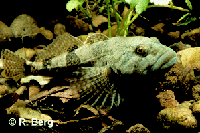 " typeof=
" typeof=
- The Bullhead (Cottus gobio) occurs in fast-flowing streams and rivers, hiding under rock, between water plants and roots, and can hardly be discovered due to its brownish colour with mottling. Interestingly, the male watch over the spawn attached to the undersides of large stones. Bullheads are occurring in the rivers Murg and Rhine and in connected streams. Read more
Lampreys are fish-like vertebrates with gills, i.e. they are no true fish. They have an eel-like, elongated body. Seen from the side the lampreys show seven branchial clefts, an eye and a nasal opening. This was the reason for the mistakable German name “nine-eye”. Their larvae live for several years in tubes at the bottom of rivers and streams where they filter the water for nourishment.
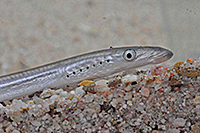 " typeof=
The Sea Lamprey (Petromyzon marinus) is a migratory fish living close to sea and moving offshore for spawning, e.g. into the river Rhine. Such migratory fish are called “anadromous” (sea going) species. Sea lampreys spawn in some faster flowing secondary channels of the Rhine and in the river Murg. Read more
" typeof=
The Sea Lamprey (Petromyzon marinus) is a migratory fish living close to sea and moving offshore for spawning, e.g. into the river Rhine. Such migratory fish are called “anadromous” (sea going) species. Sea lampreys spawn in some faster flowing secondary channels of the Rhine and in the river Murg. Read more
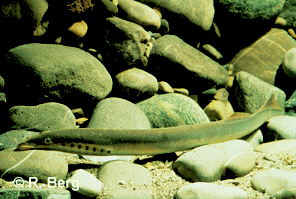 " typeof=
As an adult fish the River Lamprey (Lampetra fluviatilits) lives in the North Sea for one or two years. It reaches up to 50 cm and feeds as parasite by sucking its funnel-like mouth to other fish. Only for spawning it migrates again upstream, e.g. along the river Rhine. The larvae, called ammocoetes, live here for about four years in slowly flowing streams and rivers in the soft sediment, e.g. in the area of the Murg estuary. Read more
" typeof=
As an adult fish the River Lamprey (Lampetra fluviatilits) lives in the North Sea for one or two years. It reaches up to 50 cm and feeds as parasite by sucking its funnel-like mouth to other fish. Only for spawning it migrates again upstream, e.g. along the river Rhine. The larvae, called ammocoetes, live here for about four years in slowly flowing streams and rivers in the soft sediment, e.g. in the area of the Murg estuary. Read more
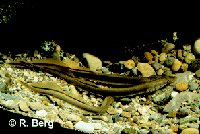 " typeof=
" typeof=
- Only the Brook Lamprey (Lampetra planeri) exclusively inhabits freshwater. In the area it occurs in the sandy and gravelly areas of the river Murg. Read more



